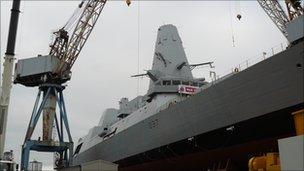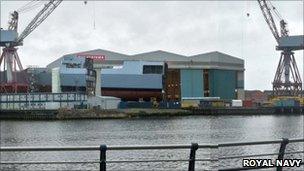HMS Duncan launch 'something to savour'
- Published

HMS Duncan is being launched at high tide
The champagne bottle smashes, the chains roar and thousands of tonnes of metal slide into the Clyde.
It is a scene which has been repeated hundreds of times over the past two centuries.
But high tide on Monday afternoon could mark the end of this spectacular tradition.
A 7,500-tonne destroyer, HMS Duncan, may be the last ship to go rattling and splashing into the river.
Named after Admiral Duncan, who defeated the Dutch fleet at the Battle of Camperdown in 1797, HMS Duncan is the sixth and final Type 45 destroyer to be built at Govan for the Royal Navy.
The next generation of warships will not have such a grand entrance, even if they survive the government's Strategic Defence and Security Review, expected later this month.
The hull sections of two Queen Elizabeth class aircraft carriers being built at BAE Systems Surface Ship's yard at Govan will be sent by barge to Rosyth, in Fife, for assembly.
And the Type 26 frigate, which is still at the design stage, is to be constructed in purpose-built docks and floated out.
So HMS Duncan may be afforded a place in history simply by making the short journey across the River Clyde for outfitting at Scotstoun.
When we stepped aboard a few days before the launch, the operations room was abuzz with activity.
A worker in a white helmet and protective glasses popped his head up from a hatch in the floor.
Another man was drilling a plate onto the wall. A third was climbing a ladder and feeding cable to yet another colleague, hidden among the electrical spaghetti.
In all, some 400 people were working on the ship.
'Hustle and bustle'
But only a handful will be on board when the champagne crashes into the bow, signalling a descent into the water at five metres per second.
Lyn Gordon, 23, an apprentice fabricator from Greenock, will be one of them.
"I'm there as a safety precaution," she explained.
"I'll be standing up on deck on the ship as it's going into the water.
"Red flag for no, white flag for yes.
"I'm hoping it's a white flag and I'm hoping I stay pretty dry."
Like many of her colleagues, Ms Gordon is then due to transfer to work on the aircraft carriers.

The Type 45 destroyer has been built at Govan on the Clyde
She would not be drawn on the controversy about their future, saying only: "One way or another we're always going to need ships so I'll always have a job."
It's not so long since such optimism was in short supply on the Clyde.
The destroyers have provided welcome security but the industry is a shadow of its former self.
Down river in Greenock, Duncan McNeil MSP remembers the glory days.
He said: "It was invigorating. It was hustle and bustle, a community that was built on shipbuilding and all the associated jobs."
Until closure in 1988, Mr McNeil was shop stewards' convener at Scott Lithgow on the Lower Clyde.
"There was thousands of people working directly in the yards in the lower reaches of the Clyde.
"It was the heart of the economy. It dominated completely."
'Heart of economy'
And Mr McNeil insists the industry still matters for Greenock and Port Glasgow.
"It's very important to my community still," he added.
"Around 500 people travel to work on the upper reaches of the Clyde, 500 families are dependent on that work."
They are among some 4,000 people employed today at Govan and Scotstoun.
For the more experienced, Monday's launch may renew concern for the future.
But David Connelly, ship manager of Duncan for BAE, who will also be on board, said he intended to savour the moment.
"It's something you remember all your days," he said.
"As soon as this one hits the water it's the same feeling of pride."